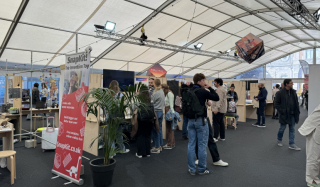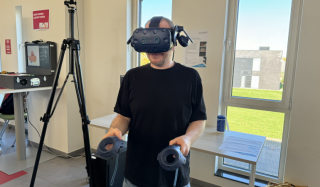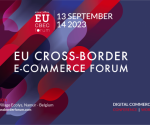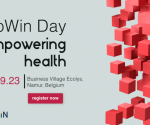
Wallonia, a digital hub? That is the goal of the Digital Wallonia platform that brings together digital players for a global showcase of the digital accomplishments of the Walloon Region. Economic missions are being organised under its banner.
Last January, Las Vegas hosted the CES (Consumer Electronics Show), the largest world-wide electronics gathering place for the general public. Under the Digital Wallonia banner, an AWEX exploratory mission saw 17 Walloon companies head for the American city. In February, other Walloon companies participated in the Mobile World Congress in Barcelona. Back in October and November 2015, a dual mission on smart cities had travelled to Issy-les-Moulineaux, Strasbourg, Bordeaux and Nantes. Steered by the AWEX and under the Digital Wallonia banner, it involved seventy or so companies, cities, associations and institutions. The logo is now an integral part of Wallonia’s overall digital strategy. "In terms of marketing and business power, this paradigm shift is huge”, says André Blavier, web & communication expert of the Agence du Numérique (Digital Agency). “More than just an institution, Digital Wallonia is a global services platform, a brand in its own right."
What is the objective of the Digital Wallonia platform? "The aim is to create an identity and a strong brand, unifying digital technology for all digital players in Wallonia, earmarked for the private and public sectors, users, the digital sector itself, businesses and education and academia, all this via one single website in Wallonia. This approach is similar to what is being done in France with French Tech or in the UK with Tech Nation. The idea is for the brand to be used tomorrow at exhibitions abroad."
4,000 company profiles, 25,000 contacts
The Digital Wallonia strategy is derived from the 2015 Assises du Numérique (Digital Conferences), with the collaborative website of the Printemps du Numérique (Digital Spring) and the establishment of the Digital Council, chaired by Pierre Rion. "At the Digital Agency, we set up 13 thematic working groups to draft proposals for a strategic plan. The strategy was adopted in late December 2015. The participants, companies, private and public sectors, voiced their priorities. The first was to solve the problem of the dispersion of tools, the multiplicity of initiatives. The first service of Digital Wallonia is to offer a global vision of the digital sector. It was necessary to structure, develop and activate it, via dynamic mapping for instance. Today, the platform brings together 4,000 company profiles, 25,000 contacts, with a smart company identification system. Just tag them to instantly create virtual catalogues or technology clusters. Companies within the digital sector itself and businesses developing related products or services (sensors, security, smart furniture, open data platform for services) are identified. It is interesting to add university laboratories where research is conducted in the field, as well as the Walloon cities that have introduced smart city initiatives. We may even be adding schools that offer specific training on connected objects, for example."
Bringing together the research players
Digital Wallonia addresses five priority targets. The first is the digital sector itself. "Digitising businesses and services with American, English, French or German products does not create added value in Wallonia. We need research and development, and an innovative representative sector for Wallonia’s flagship digital companies to be in demand abroad. EVS is a case in point. It is a key global player for the Olympic Games and other major sporting events. There are others. With the creation of the Digital Wallonia hub, the idea is to bring together all the research stakeholders that are currently working in a dispersed manner. Today, while the tools may make it possible to work together without creating physical institutions, it is still essential for the research players to brainstorm. A digital fund will also be created for start-ups."
The second target relates to the other companies, construction industries, agriculture, biotechnology, mobility, etc. "To survive, these sectors must also embrace the digital world. With the competiveness clusters, we conduct awareness and digital maturity campaigns so that the development of the economy is increasingly driven by digital. Today, it is impossible to envisage the development of biotech, agriculture, distribution, logistics, etc., without taking into account the digital dimensions."
Training and smart cities
The third target is the world of education. "This includes learning coding in schools, but also ensuring that these schools have the necessary equipment, connectivity and hardware, on-site or brought in by the students, and properly trained teachers. Today, strong digital skills are essential to find a job." The fourth target is the public sector, with activities related to the digitisation of services (online forms, etc.). "With trends such as open data, i.e. opening the data of the public service to companies or developers, etc. – another huge challenge." Finally, the fifth target is territorial. This aspect is important and cross-cutting and relates in particular to smart cities. "The goal is to make the Walloon Region more digital. This involves high-speed broadband, connectivity, fibre optics, ensuring that every citizen and every business has an ultra-fast broadband and/or mobile connection wherever they are in Wallonia, and concepts related to the territory. For example, when you leave Wallonia and enter France. We will work to make cities smart and health connected."
More visibility and specific economic missions
What are the concrete benefits for Walloon companies, whether digital or not? "The public and private initiatives in the field of ICT are aligned, intensive and visible. The Walloon digital ecosystem is clearly identified inside and outside. The uses are disseminated to different sectors, schools, public and private services, citizens ... Companies and innovators are identified and their activities are supported. The platform’s services are open and usable by all. With the platform, each partner has its visibility, its attractiveness and its pull effect, while preserving its identity and its own missions."
Today, in Wallonia, over 500 million euros have been mustered to be spent over four years on actions for the Region’s digital transformation. This budget should be distributed as follows: 44% for the digital sector, 30% for the digital economy, 19% for the connected and smart territory, 7% for public services and 20% for skills and jobs. "That is why, in 2016, the AWEX has specifically allocated resources for trade shows or events with a digital relevance. The goal of the Digital Council is to ensure that the government effectively follows up on its commitments. At the Digital Agency, we will adopt collaborative governance and integrate the AWEX, the clusters, Agoria, the federation of the technological sector and other sectoral federations. By mid-2016, company catalogues, currently in French, will be offered in English and in French.” The virtual road of Digital Wallonia has a bright future ahead of it.
Jacqueline Remits
This article is from the W+B Magazine 131.









